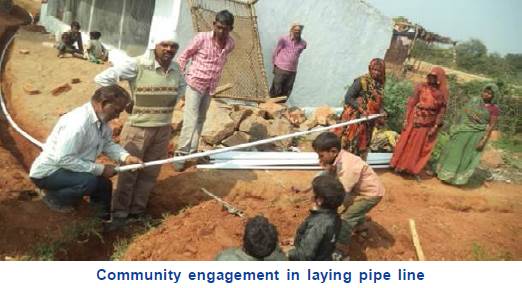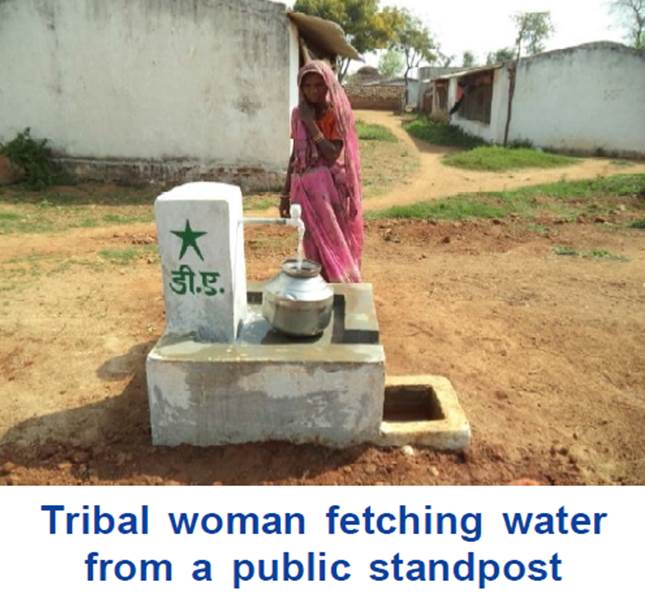Community Owned Solution
To Access Safe Drinking Water
G
lobal warming, population growth, urbanisation and growing consumption of water and energy continue to disrupt our already fragile ecosystems. These unsustainable trends are reinforced by market and political drivers that still tend to favour further development of water intensive activities in arid and semi - arid areas where there is not much water available.Susceptible to frequent droughts, the Bundelkhand region
in Central India experiences acute water-stress. Various anecdotal surveys
by NGOs point that women and young girls walk 4-5 hours to fetch water every
day. The scarcity of drinking water has immense health ramifications. With
daytime temperatures hovering above 40 degrees during April-August, water
scarcity leads to dehydration and di arrhoea.
arrhoea.
Community Owned, Community Operated (CO-CO) model in village Pipra
Pipra is a small village in the Niwari block of Tikamgarh
district in Madhya Pradesh. There was a severe drought in Bundelkhand in
2012, which lasted four years. As a solution to the severe drinking water
stress observed in Pipra, Development Alternatives proposed the installation
of a solar energy based drinking water system. This would pump ground water
from a bore well and supply to the household and public connections. The
option of using solar energy was found to be more reliable than grid power
for providing uninterrupted, affordable and clean power. Household and
c ommunity level water connections were provided to the people, who now boast
of an uninterrupted water supply throughout the year. To ensure that the
system remains sustainable beyond the period of DA’s intervention in the
village, the system has been implemented as a Community Owned, Community
Operated (CO-CO) model where a Pani Panchayat (Water Committee) has
been formed which comprises of members from different settlement areas
within the village ensuring equal representation of people from all castes
and genders. The members have been trained on operating and maintaining the
infrastructure and system with monthly collection of a water service fee
from the entire community. This amount is used to maintain the
infrastructure and pay a stipend to a person who is responsible for
operating and maintaining the infrastructure. It has been three years now
and the village has round the year water supply even when there is water
scarcity in the entire Bundelkhand region.
ommunity level water connections were provided to the people, who now boast
of an uninterrupted water supply throughout the year. To ensure that the
system remains sustainable beyond the period of DA’s intervention in the
village, the system has been implemented as a Community Owned, Community
Operated (CO-CO) model where a Pani Panchayat (Water Committee) has
been formed which comprises of members from different settlement areas
within the village ensuring equal representation of people from all castes
and genders. The members have been trained on operating and maintaining the
infrastructure and system with monthly collection of a water service fee
from the entire community. This amount is used to maintain the
infrastructure and pay a stipend to a person who is responsible for
operating and maintaining the infrastructure. It has been three years now
and the village has round the year water supply even when there is water
scarcity in the entire Bundelkhand region.
Conclusion
It has been found by NABARD that in several villages piped water supply has been installed but 90% of this infrastructure is not functional due to non - availability of assured power and management of the system. Most of the piped water supply and tanks are empty due to lack of ownership and control mechanism for providing services of water delivery. Therefore the COCO model could be a useful model for strengthening the system through community engagement.
The CO-CO model for ensuring access to drinking water systems stems from the fundamental ideology of community ownership of resources and decentralised governance. The community not only owns the resources it consumes but is also jointly responsible for its care and maintenance. With the monthly collection of service fee, this model deems to be economically effective for the village people as the people do not have to pay huge money to the water mafia or walk extremely long distances to fetch water thereby loosing time for productive work in their fields or for other work. q
Deepak Mohanty
dmohanty@devalt.org
and Chandan Mishra
ckmishra1@devalt.org